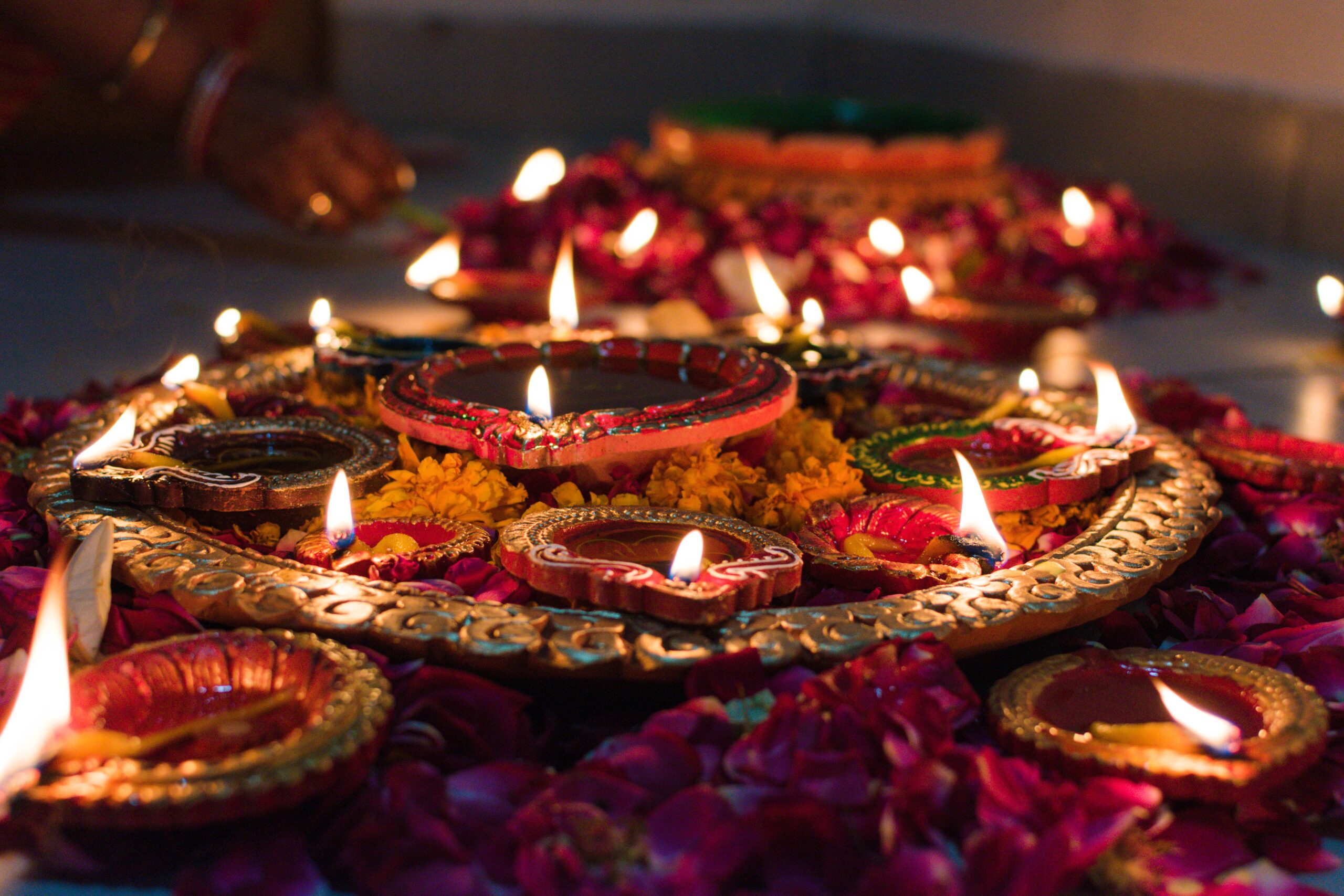
Culture Wrappings
Culture and religion aren’t merely things you carry with you. For some reason, I thought they were just two significant chunks of the building material shaping the me-ness. But I learned over time that they are things which largely exist in boxes.
That way they can be taken out and displayed/used/worn/shared at the appropriate times before being reorganized and packed away. Every time, it seems that less of it gets unpacked, or what is drawn from these boxes is different to what I expected.
In my pre-teens and early teens, I collected all of my stray glass bangles that had survived the disappearance of the rest of a set. Ones that could no longer be worn with Indian clothes because there weren’t enough of them anymore. I wore a curated selection of three or four on each wrist with western clothes in my little nod to fusion style.
On the one hand, I was proud of my culture, which had little or no chance to shine on an ordinary school day. On the other hand, the different patterns and colors mixed with gold and sometimes a bit of cheap sparkles were just pretty. The sweet clinking sound they made whenever I moved was comforting because of the times and places with which I associated it.
My friends liked to amuse themselves by jingling them, my family found this new habit weird and weren’t shy about commenting on it; as if I wasn’t even aware of what I was wearing. They didn’t see Indian bangles with western clothing as fusion. Rather, an odd pairing, like a wedding guest who shows up to the wrong wedding. Indian bangles with a ghagra (also known as lengha) and that necklace with your name written on a rice grain (laugh if you want, but they were big in the nineties) with jeans and a blouse.
Culture and religion were chunks of life which remained largely unchanged, and which were only made visible in specific circumstances. Afterwards, they were packed away and we went back to existing as kids who were supposed to be proud of being American even if it would be a cold day in hell before we would be allowed to start acting like our white, American peers.
It sounds a bit isolating and in some ways it felt that way. But what I saw as hypocrisy as a kid, adult me now realizes was perhaps an overzealous fight to not allow our unique experiences to be homogenized by what western culture viewed us as. What that means is that we looked forward to unpacking all the boxes for Diwali not in the least because our parents tended to be a bit calmer then.
While I hesitate to simplify it as ‘the new year,’ it is a day celebrated by multiple faiths, so it’s not an inaccurate description. My Diwali and that of my parents are vastly different experiences. For my parents, growing up in Fiji, it seems to have been one part thinking of the deities, three parts mithai-fuelled block party, with kids in new clothes racing through a fog of toxic firework smoke, a lit sparkler fizzing in each sticky hand. In contrast, my parents scoffed at the idea of leaving the house on the day of. It was ridiculous to leave lit diyas unattended and Lakshmi would never bless an empty house.
I can only describe my Diwali as something very gentle. We spent days before cleaning the house and the statues and pictures for our altar. The day itself was dedicated to cooking a feast before we showered and dressed in Indian clothes – religious function nice, not wedding nice. After praying together, we trailed my mother through the house, each of us with a hand on her right arm as she set clay diyas on teacup saucers splashed with a bit of water, in the dark rooms of our house.
Afterwards, only the kitchen light was turned on again out of necessity and we ate the prasad and massive spread that my mom had mostly cooked on her own. While we ate, she told us stories from The Ramayana. Despite there only being four of us, she had cooked party food staples like gulgula and samosa – the best part of this is not having to send people home with all the tasty leftovers. Nobody raised their voice or even spoke superfluously. It was a time to be together and celebrate the warmth and security of home.
The first Diwali after my mother died, our home shivered with that kind of cold, unique to sudden absence. It was just my older sister and me, my dad was on a business trip. As the oldest woman she became the Lakshmi of the home. So she cooked most of the food and I trailed along behind her, one hand on her arm as we set out the diyas. Afterwards, we broke the usual rule and watched DVD episodes of the serialized The Ramayana, sinking into its comfort and blocking out our loneliness for a few hours.
Not to say that my mother was the linchpin to our culture and traditions, but in spite of the distant knowledge that my parents’ experiences were different to my own, this was the first time I understood that traditions do and often have to adapt.
Like pretty much every holiday celebrated on a large scale, Diwali too is swept along with the changing times. The buttery scent of ghee in clay diyas, soaking into twisted cotton wicks is joined by tealights and even LED diyas. You can find practically any bhajan song on YouTube. Articles offering tips for Diwali always include how to make it a greener celebration – like avoiding those beloved fireworks and the trash they leave behind – and how to detach Diwali from that familiar abscess of commercialism.
Up to now, I’ve never heard anyone complaining about Diwali being too capitalistic. Maybe that’s a blessing and a curse because having lived in places where Diwali is usually just a vague blip on the larger cultural radar means I am freed from any commercial trappings and can sink into a day that is more ‘back to basics,’ although I did briefly consider buying lotus shaped string lights and a ‘Happy Diwali’ garland. But, as the only one in my immediate circle who celebrates Diwali, there is a deeply rooted and utterly ridiculous fear that what I have to offer on this day won’t be cultural enough, whatever that means. As the only representative of this important day, I carry an irrational fear that someone will look at something and say, that’s wrong.
Then December hits and suddenly someone has flipped the switch on this quietly meditative time and has started blaring Christmas music. Finally I can appreciate the cookies and stollen that have been in stores since September. Every day seems like a countdown to the opening of Christmas markets and wondering now is it cold enough for mulled wine?
It’s a time I look forward to and one that my bank account hates. I often get asked if I even celebrate Christmas, with that typical scrunchy faced expression of someone who assumes the answer is no (not that I’m assuming of course that everyone celebrates) and my standard tongue-in-cheek response used to be that I celebrate in the capitalist way.
Over time, I’ve found less humor in that. Of course, spending time with the people you love is one of the mainstays of this time of year. But winter – and here I’m using living in Germany as a specific example – is supposed to be a time to slow down and enjoy a cozier way of life. Instead, many of my students are fitting in extra hours of work when they get home and I am also working as much as possible to put a little extra padding in my bank account. There are spontaneous visits to a Christmas market, last minute gifts, and extra ingredients for dinners that add up quickly.
It isn’t the pressure to buy the most expensive thing, or even a lot of stuff. In fact, many people I know try to focus more on spending time together. But even time is a thing which is capitalized whether it’s doing activities that require spending money, or when you end up talking about work around the dinner table. A tradition that my dad and I still have, is to watch The Muppet Christmas Carol together, a tradition which dates back to the glory days of VHS. However, given the divide and conquer strategy of streaming services however, that’s currently not possible.
I feel that pressure squeezing my time from both sides so that any downtime is marred by guilt for not doing something profitable. But let me be clear; I don’t regret the money I spend on gifts and food. I like giving gifts and feeding people and making these shared traditions.
Afterall, I’m hardly a unique example of someone who has had to make their own traditions from a patchwork of their roots and experiences. This is the time of year when it comes out in the best way. Celebration to me means our community, all from different backgrounds, coming together to offer up a piece of their personal history for everyone to try and enjoy. No holiday season is complete unless you’ve come away with a few recipes in your back pocket.
Afterwards, when we’ve entered into the new year, there will be a few weeks of cushioning in which the decorations remain and there’s a lot of leftovers to get through. But then comes the inevitable time when corners are dotted with tree collection bins and the cozy lights are stripped away, leaving us shivering in the harsh colorless gloom of January and February. The decorations are packed up and wrapped in their boxes again and life goes on. I might buy those string lights for Diwali next year though.

